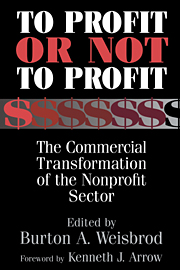Book contents
- Frontmatter
- Contents
- List of contributors
- Foreword by Kenneth J. Arrow
- Preface
- 1 The nonprofit mission and its financing: Growing links between nonprofits and the rest of the economy
- Part I Basic issues and perspective
- Part II Industry studies
- 8 Commercialism in nonprofit hospitals
- 9 Universities as creators and retailers of intellectual property: Life-sciences research and commercial development
- 10 Commercialism in nonprofit social service associations: Its character, significance, and rationale
- 11 Zoos and aquariums
- 12 Commerce and the muse: Are art museums becoming commercial?
- 13 The funding perils of the Corporation for Public Broadcasting
- Part III Overview, conclusions, and public-policy issues
- Appendix: IRS Forms 990 and 990-T for nonprofit organizations
- References
- Index
13 - The funding perils of the Corporation for Public Broadcasting
Published online by Cambridge University Press: 30 November 2009
- Frontmatter
- Contents
- List of contributors
- Foreword by Kenneth J. Arrow
- Preface
- 1 The nonprofit mission and its financing: Growing links between nonprofits and the rest of the economy
- Part I Basic issues and perspective
- Part II Industry studies
- 8 Commercialism in nonprofit hospitals
- 9 Universities as creators and retailers of intellectual property: Life-sciences research and commercial development
- 10 Commercialism in nonprofit social service associations: Its character, significance, and rationale
- 11 Zoos and aquariums
- 12 Commerce and the muse: Are art museums becoming commercial?
- 13 The funding perils of the Corporation for Public Broadcasting
- Part III Overview, conclusions, and public-policy issues
- Appendix: IRS Forms 990 and 990-T for nonprofit organizations
- References
- Index
Summary
Introduction and perspective
On November 5, 1967, President Lyndon Johnson signed into law the Public Broadcasting Act, creating the Corporation for Public Broadcasting (CPB). The purpose of the act, Johnson said, was to “renew the promise of the vision in the word ‘television.’” Johnson described the new CPB as “the people's corporation. Fully independent. Broadly representative. Supported by public and private money. Free from interference by private interests, government agency, or political party” (Johnson 1967).
“Public” radio and television are industries that illustrate well the interplay of outputs and mechanisms to finance them. The collective-goods aspects of their broadcast outputs are unusually large; the process of production and distribution of programs is such that the incremental costs of serving additional listeners or viewers is essentially zero, and it is costly, though not impossible, to limit listener and viewer access (Owen and Wildman 1992).
These are the precise conditions of production under which financial problems emerge. With user fees to listeners being infeasible, dependence on contributions, gifts, and grants becomes great. Because grants from government have fallen in recent years, public broadcasting has had to pursue all of its principal finance options: It has moved aggressively to expand private donations, especially through “memberships”; and it has worked to increase revenues from each of its two potential sources of sales – user fees from its advertisers and “underwriters,” and ancillary services that are complements of the broadcast process.
- Type
- Chapter
- Information
- To Profit or Not to ProfitThe Commercial Transformation of the Nonprofit Sector, pp. 249 - 268Publisher: Cambridge University PressPrint publication year: 1998
- 2
- Cited by



